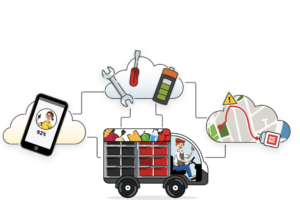Picnic makes grocery delivery effortless for the customer and even makes the whole process seem effortless. However, behind the scenes, Picnic has built up a system of both hardware and software solutions to make this possible. The hardware layer includes distribution and fulfillment centers, hubs, trucks, and vans. The software layer includes apps for both customers and employees as well as many backend services.
Often, these two layers are connected, in order to monitor or automate processes. So far Picnic’s last-mile delivery vehicle had escaped such oversight. Now Picnic has started to fully incorporate the vehicle into their IT ecosystem to fully leverage the potential for automatic asset tracking, automating maintenance request to reduce vehicle downtime, tracking battery health of individual vehicles to improve vehicle to trip planning, and thus vehicle utilization and tailor-made coaching for our drivers, based on their driving actions, to improve safety and vehicle range.
The last-mile vehicle that Picnic sends hundreds of different data points over its CAN bus, from the state of charge of the battery to whether the lights are activated or by how much the accelerator is pressed. Picnic’s Joris Wolters: ‘The possibilities are endless for connected vehicles and you could lose yourself in them. It, therefore, remains essential to keep the focus on the original goal: creating a safe, stress free and fun working environment for our Runners all while getting the most out of our vehicles. A happy Runner is a happy customer. That truly creates the value that is Picnic’.

